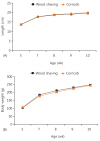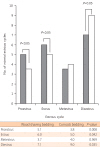Ann Pediatr Endocrinol Metab.
2015 Mar;20(1):53-58. 10.6065/apem.2015.20.1.53.
Comparison of growth and pubertal progression in wild type female rats with different bedding types
- Affiliations
-
- 1Department of Pediatrics, Kyung Hee University Hospital at Gangdong, Seoul, Korea. ksshim64@gmail.com
- 2Department of Pediatrics, Kyung Hee University Hospital, Kyung Hee University School of Medicine, Seoul, Korea.
- KMID: 1789532
- DOI: http://doi.org/10.6065/apem.2015.20.1.53
Abstract
- PURPOSE
Endocrine-disrupting chemicals interfere with the endocrine system and therefore affect growth and pubertal progression. The study aim was to compare the growth and pubertal progression in wild-type female rats with different bedding types.
METHODS
Twenty 5-week-old female wild-type Sprague Dawley rats were randomly assigned to two groups with different bedding types: one group received wood shaving bedding, while a second group received corncob bedding. We determined crown-rump length and body weight as anthropometric measurements and assessed the serum growth hormone (GH) and estradiol levels. The gh1 mRNA expression levels were compared using quantitative real time transcription polymerase chain reaction. The estrous cycle was evaluated by vaginal smear.
RESULTS
The anthropometric measurements were not significantly different between the two groups. The mean relative expression of the gh1 gene was lower in the corncob bedding group than that in the wood shaving group (P=0.768). Meanwhile serum GH and estradiol were increased in the wood shaving bedding group; however this difference was not statistically significant. The time to first estrus and the length of the estrous cycle were increased in the corncob bedding group; the proportion of normal estrous cycles was also decreased. These findings indicate irregularities in the estrous cycle.
CONCLUSION
Endocrine-disrupting chemicals in corncob bedding might be associated with time to first estrus and length of the estrous cycle. Therefore, the type of bedding should be considered as a factor affecting pubertal progression in rodents.
Keyword
MeSH Terms
-
Adolescent
Animals
Bedding and Linens
Body Weight
Crown-Rump Length
Endocrine Disruptors
Endocrine System
Estradiol
Estrous Cycle
Estrus
Female
Growth Hormone
Humans
Polymerase Chain Reaction
Puberty
Rats*
Rats, Sprague-Dawley
RNA, Messenger
Rodentia
Vaginal Smears
Wood
Endocrine Disruptors
Estradiol
Growth Hormone
RNA, Messenger
Figure
Reference
-
1. Diamanti-Kandarakis E, Bourguignon JP, Giudice LC, Hauser R, Prins GS, Soto AM, et al. Endocrine-disrupting chemicals: an Endocrine Society scientific statement. Endocr Rev. 2009; 30:293–342. PMID: 19502515.
Article2. Kim SH, Park MJ. Endocrine disrupting chemicals and pubertal development. Endocrinol Metab. 2012; 27:20–27.
Article3. Krohn TC, Hansen AJ. Evaluation of corncob as bedding for rodents. Scan J Lab Anim Sci. 2008; 35:231–236.4. Mani SK, Reyna AM, Alejandro MA, Crowley J, Markaverich BM. Disruption of malesexual behavior in rats by tetrahydrofurandiols (THF-diols). Steroids. 2005; 70:750–754. PMID: 15927221.
Article5. Markaverich BM, Alejandro M, Thompson T, Mani S, Reyna A, Portillo W, et al. Tetrahydrofurandiols (THF-diols), leukotoxindiols (LTX-diols), and endocrine disruption in rats. Environ Health Perspect. 2007; 115:702–708. PMID: 17520056.
Article6. Leys LJ, McGaraughty S, Radek RJ. Rats housed on corncob bedding show less slow-wave sleep. J Am Assoc Lab Anim Sci. 2012; 51:764–768. PMID: 23294881.7. Marcondes FK, Bianchi FJ, Tanno AP. Determination of the estrous cycle phases of rats: some helpful considerations. Braz J Biol. 2002; 62(4A):609–614. PMID: 12659010.
Article8. Leung KC, Johannsson G, Leong GM, Ho KK. Estrogen regulation of growth hormone action. Endocr Rev. 2004; 25:693–721. PMID: 15466938.
Article9. Börjesson AE, Lagerquist MK, Liu C, Shao R, Windahl SH, Karlsson C, et al. The role of estrogen receptor α in growth plate cartilage for longitudinal bone growth. J Bone Miner Res. 2010; 25:2690–2700. PMID: 20564247.
Article10. Lorand T, Vigh E, Garai J. Hormonal action of plant derived and anthropogenic non-steroidal estrogenic compounds: phytoestrogens and xenoestrogens. Curr Med Chem. 2010; 17:3542–3574. PMID: 20738246.
Article11. Adlercreutz H, Mazur W. Phyto-oestrogens and Western diseases. Ann Med. 1997; 29:95–120. PMID: 9187225.
Article12. Kouki T, Kishitake M, Okamoto M, Oosuka I, Takebe M, Yamanouchi K. Effects of neonatal treatment with phytoestrogens, genistein and daidzein, on sex difference in female rat brain function: estrous cycle and lordosis. Horm Behav. 2003; 44:140–145. PMID: 13129486.
Article13. Takagi H, Shibutani M, Lee KY, Lee HC, Nishihara M, Uneyama C, et al. Lack of modifying effects of genistein on disruption of the reproductive system by perinatal dietary exposure to ethinylestradiol in rats. Reprod Toxicol. 2004; 18:687–700. PMID: 15219631.
Article14. Jefferson WN, Couse JF, Padilla-Banks E, Korach KS, Newbold RR. Neonatal exposure to genistein induces estrogen receptor (ER)alpha expression and multioocyte follicles in the maturing mouse ovary: evidence for ERbeta-mediated and nonestrogenic actions. Biol Reprod. 2002; 67:1285–1296. PMID: 12297547.
Article15. Jefferson WN, Padilla-Banks E, Newbold RR. Adverse effects on female development and reproduction in CD-1 mice following neonatal exposure to the phytoestrogen genistein at environmentally relevant doses. Biol Reprod. 2005; 73:798–806. PMID: 15930323.
Article16. Markaverich BM, Alejandro MA, Markaverich D, Zitzow L, Casajuna N, Camarao N, et al. Identification of an endocrine disrupting agent from corn with mitogenic activity. Biochem Biophys Res Commun. 2002; 291:692–700. PMID: 11855846.
Article17. Villalon Landeros R, Morisseau C, Yoo HJ, Fu SH, Hammock BD, Trainor BC. Corncob bedding alters the effects of estrogens on aggressive behavior and reduces estrogen receptor-α expression in the brain. Endocrinology. 2012; 153:949–953. PMID: 22186416.
Article18. Goldman JM, Murr AS, Cooper RL. The rodent estrous cycle: characterization of vaginal cytology and its utility in toxicological studies. Birth Defects Res B Dev Reprod Toxicol. 2007; 80:84–97. PMID: 17342777.
Article19. Freeman ME, Knobil E, Neil JD. Neuroendocrine control of the ovarian cycle of the rat. In : Knobil E, Neill JD, editors. physiology of reproduction. New York: Raven Press;1994. p. 613–658.
- Full Text Links
- Actions
-
Cited
- CITED
-
- Close
- Share
- Similar articles
-
- The Effects of Growth Hormone on Pubertal Maturation
- A longitudinal study on the pubertal growth peak and maturity stages of the hand-wrist in malocclusion
- Pubertal growth and epiphyseal fusion
- A longitudinal study on the interrelation between pubertal growth and sexual maturity in malocclusion
- Effect of ethylene glycol monoethyl ether on the spermatogenesis in pubertal and adult rats







